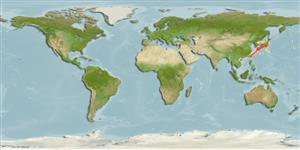Environment: milieu / climate zone / depth range / distribution range
Écologie
marin bathydémersal; profondeur ? - 1281 m (Ref. 26282). Deep-water
Northwest Pacific: Japan (Ref. 559) and the China (Ref. 44036).
Taille / Poids / Âge
Maturity: Lm ? range ? - ? cm
Max length : 170 cm SL mâle / non sexé; (Ref. 559)
Description synthétique
Clés d'identification | Morphologie | Morphométrie
Épines dorsales (Total) : 0; Rayons mous dorsaux (Total) : 9 - 10; Épines anales: 0. Pelvic fin short, not reaching below insertion of pectoral fin; its length contained 5.4 times in head length. Pelvic girdle narrow, with a median foramen. Attains 1.7 m SL.
Life cycle and mating behavior
Maturities | Reproduction | Spawnings | Egg(s) | Fecundities | Larves
Masuda, H., K. Amaoka, C. Araga, T. Uyeno and T. Yoshino, 1984. The fishes of the Japanese Archipelago. Vol. 1. Tokai University Press, Tokyo, Japan. 437 p. (text). (Ref. 559)
Statut dans la liste rouge de l'IUCN (Ref. 130435)
Menace pour l'homme
Harmless
Utilisations par l'homme
Outils
Articles particuliers
Télécharger en XML
Sources Internet
Estimates based on models
Preferred temperature (Ref.
123201): 6.1 - 12.9, mean 8.8 °C (based on 49 cells).
Phylogenetic diversity index (Ref.
82804): PD
50 = 0.5315 [Uniqueness, from 0.5 = low to 2.0 = high].
Bayesian length-weight: a=0.00389 (0.00180 - 0.00842), b=3.12 (2.94 - 3.30), in cm total length, based on all LWR estimates for this body shape (Ref.
93245).
Niveau trophique (Ref.
69278): 4.3 ±0.7 se; based on size and trophs of closest relatives
Fishing Vulnerability (Ref.
59153): Very high vulnerability (90 of 100).
